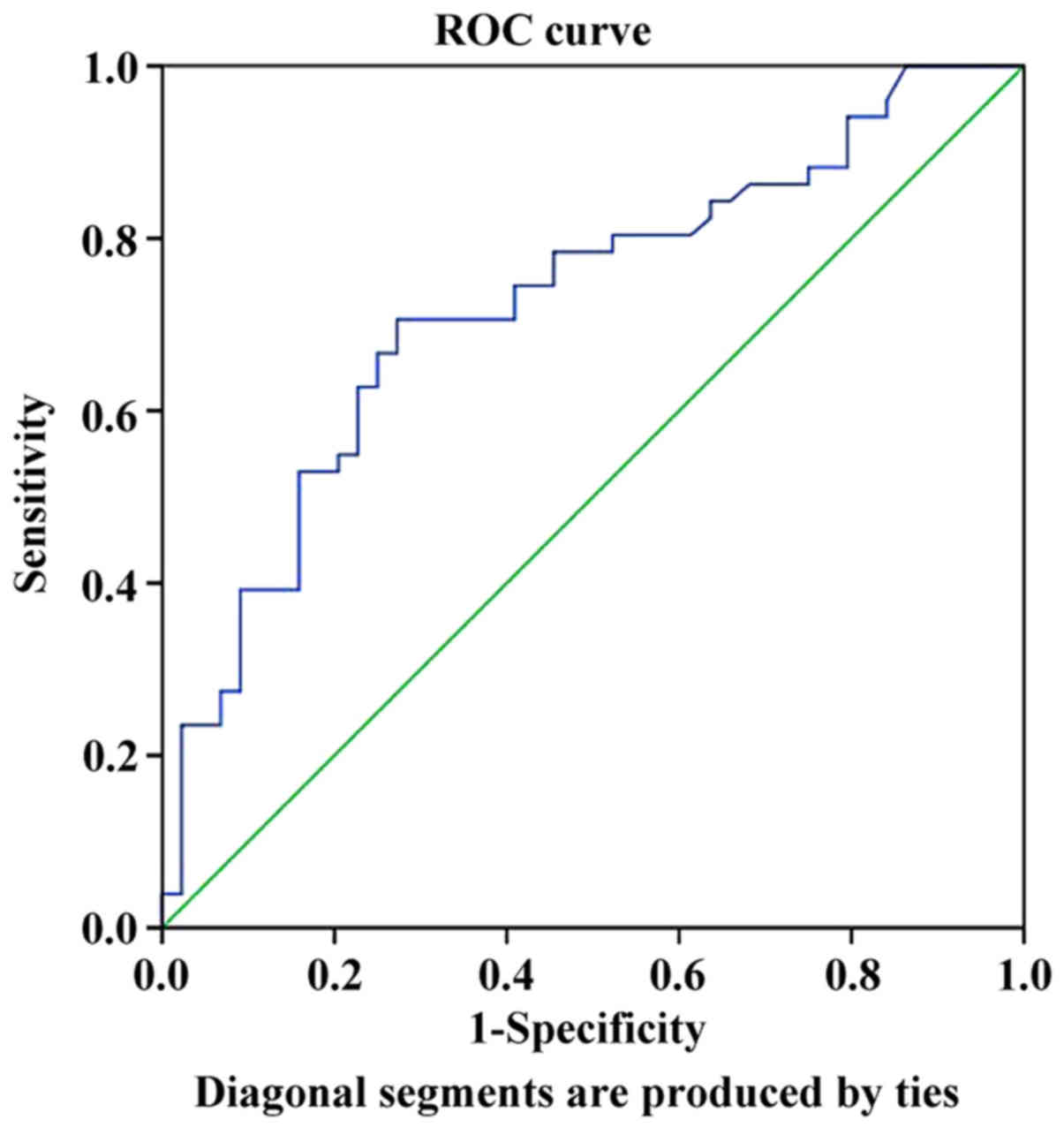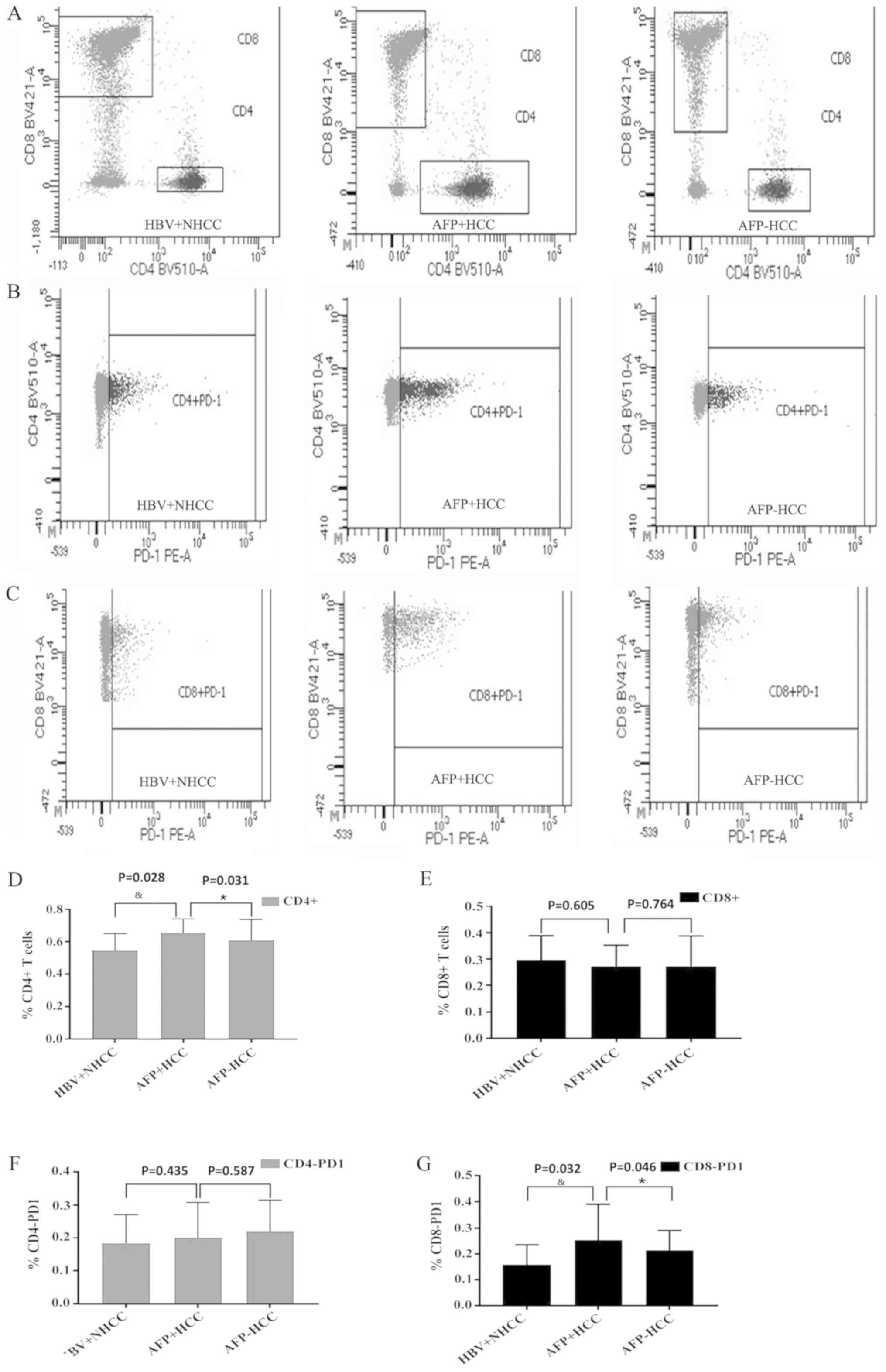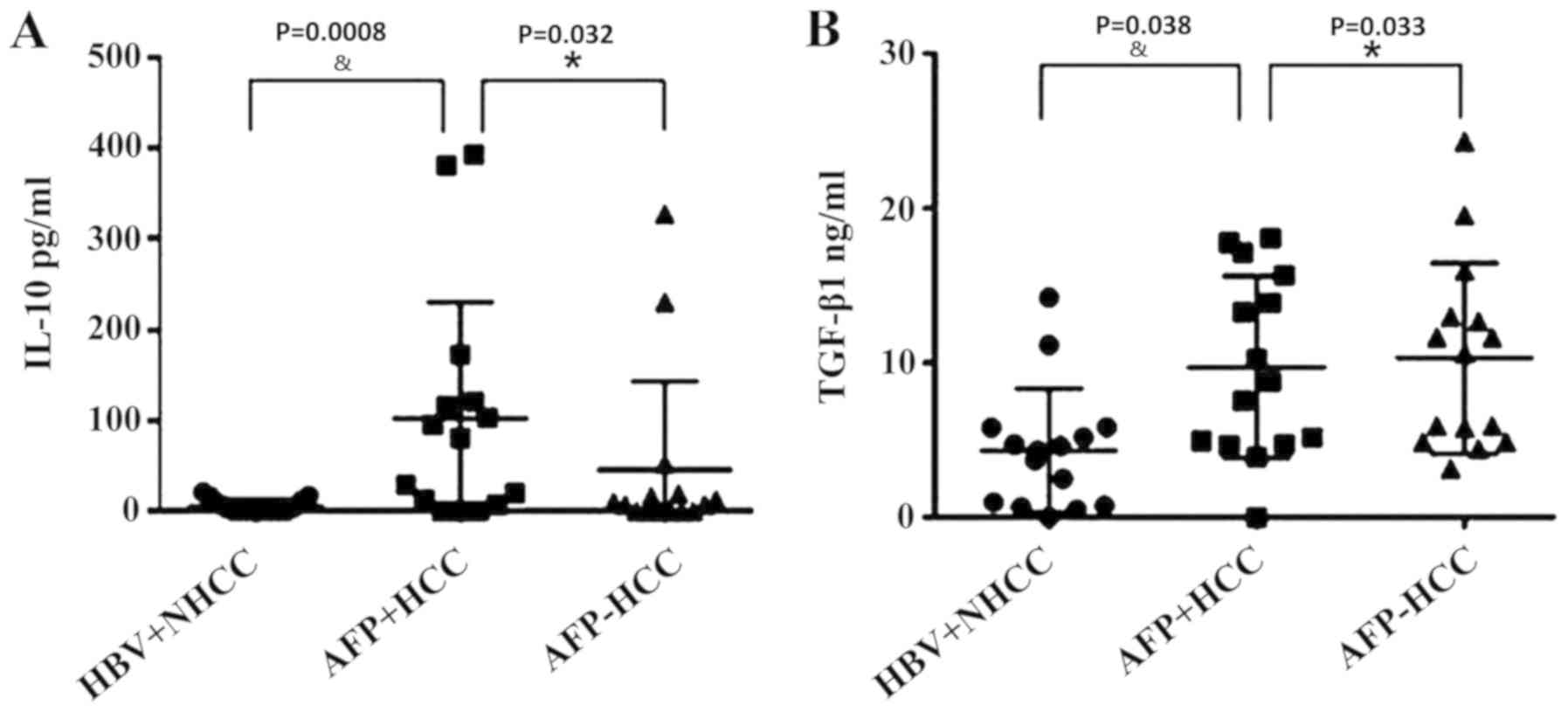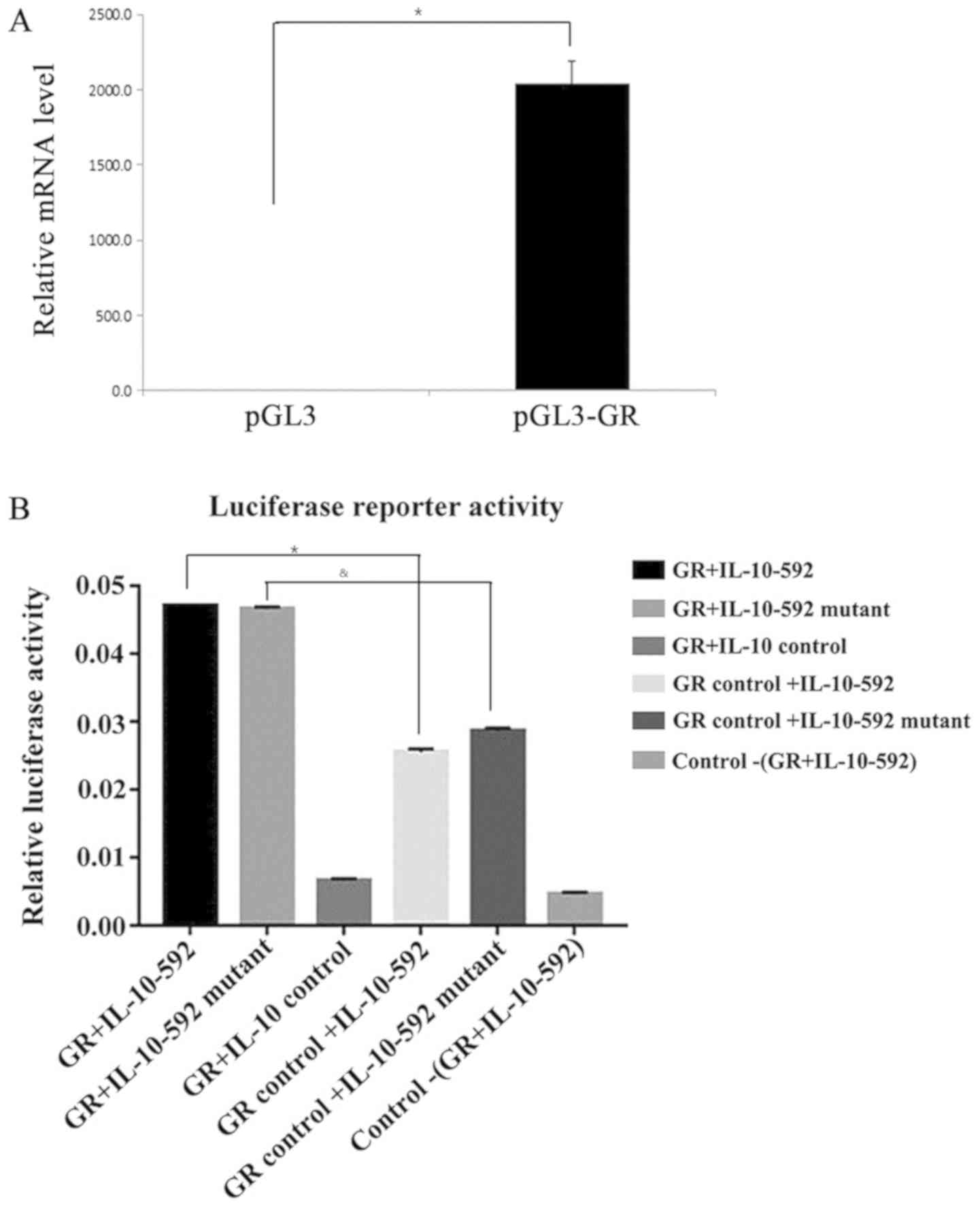|
1
|
Nakamoto Y: Promising new strategies for
hepatocellular carcinoma. Hepatol Res. 47:2673–265. 2017.
View Article : Google Scholar
|
|
2
|
Pu C, Jiang C, Lang L, Hui H, Wang Z, Ma D
and Zhang Y: Combination of microRNAs and cytokines: A method for
better evaluation of acute-on-chronic liver failure. Clin Lab.
64:247–256. 2018. View Article : Google Scholar : PubMed/NCBI
|
|
3
|
Wang X, Yang J, Xing Z, Zhang H, Wen Y, Qi
F, Zuo Z, Xu J and Yao Z: IL-4 mediates the delayed neurobehavioral
impairments induced by neonatal hepatitis B vaccination that
involves the down-regulation of the IL-4 receptor in the
hippocampus. Cytokine. 110:137–149. 2018. View Article : Google Scholar : PubMed/NCBI
|
|
4
|
Tao NN, Gong R, Chen X, He L, Ren F, Yu
HB, Chen J and Ren JH: Interleukin-35 stimulates hepatitis B virus
transcription and replication by targeting transcription factor
HNF4α. J Gen Virol. 99:645–654. 2018. View Article : Google Scholar : PubMed/NCBI
|
|
5
|
Gao QJ, Liu DW, Zhang SY, Jia M, Wang LM,
Wu LH, Wang SY and Tong LX: Polymorphisms of some cytokines and
chronic hepatitis B and C virus infection. World J Gastroenterol.
15:5610–5619. 2009. View Article : Google Scholar : PubMed/NCBI
|
|
6
|
Liu Z, Guo H, Gao F, Shan Q, Li J, Xie H,
Zhou L, Xu X and Zheng S: Fibrinogen and D-dimer levels elevate in
advanced hepatocellular carcinoma: High pretreatment fibrinogen
levels predict poor outcomes. Hepatol Res. 47:1108–1117. 2017.
View Article : Google Scholar : PubMed/NCBI
|
|
7
|
Bowyer C, Lewis AL, Lloyd AW, Phillips GJ
and Macfarlane WM: Hypoxia as a target for drug combination therapy
of liver cancer. Anticancer Drugs. 28:771–780. 2017. View Article : Google Scholar : PubMed/NCBI
|
|
8
|
Pesapane F, Nezami N, Patella F and
Geschwind JF: New concepts in embolotherapy of HCC. Med Oncol.
34:582017. View Article : Google Scholar : PubMed/NCBI
|
|
9
|
Zhou X, Chen J, Chen L, Feng X, Liu Z, Hu
L, Zeng Z, Jia X, Liang M, Shi B, et al: Negative regulation of
Sirtuin 1 by AMP-activated protein kinase promotes
metformin-induced senescence in hepatocellular carcinoma
xenografts. Cancer Lett. 411:1–11. 2017. View Article : Google Scholar : PubMed/NCBI
|
|
10
|
Jia W, Wu J, Jia H, Yang Y, Zhang X, Chen
K and Su F: The peripheral blood Neutrophil-to-Lymphocyte ratio is
superior to the Lymphocyte-to-Monocyte ratio for predicting the
long-term survival of triple-negative breast cancer patients. PLoS
One. 10:e01430612015. View Article : Google Scholar : PubMed/NCBI
|
|
11
|
Chang Y, Fu Q, Xu L, Zhou L, Liu Z, Yang
Y, Lin Z and Xu J: Prognostic value of preoperative lymphocyte to
monocyte ratio in patients with nonmetastatic clear cell renal cell
carcinoma. Tumour Biol. 37:4613–4620. 2016. View Article : Google Scholar : PubMed/NCBI
|
|
12
|
Chang Y, An H, Xu L, Zhu Y, Yang Y, Lin Z
and Xu J: Systemic inflammation score predicts postoperative
prognosis of patients with clear-cell renal cell carcinoma. Br J
Cancer. 113:626–633. 2015. View Article : Google Scholar : PubMed/NCBI
|
|
13
|
Chen YM, Lai CH, Chang HC, Chao TY, Tseng
CC, Fang WF, Wang CC, Chung YH, Wang YH, Su MC, et al: Baseline and
trend of Lymphocyte-to-Monocyte ratio as prognostic factors in
epidermal growth factor receptor mutant non-small cell lung cancer
patients treated with first-line epidermal growth factor tyrosine
kinase inhibitors. PLoS One. 10:e01362522015. View Article : Google Scholar : PubMed/NCBI
|
|
14
|
Shibutani M, Maeda K, Nagahara H, Ohtani
H, Sakurai K, Yamazoe S, Kimura K, Toyokawa T, Amano R, Tanaka H,
et al: Prognostic significance of the lymphocyte-to-monocyte ratio
in patients with metastatic colorectal cancer. World J
Gastroenterol. 21:9966–9973. 2015. View Article : Google Scholar : PubMed/NCBI
|
|
15
|
Memon K, Kulik L, Lewandowski RJ, Wang E,
Ryu RK, Riaz A, Nikolaidis P, Miller FH, Yaghmai V, Baker T, et al:
Alpha-fetoprotein response correlates with EASL response and
survival in solitary hepatocellular carcinoma treated with
transarterial therapies: A subgroup analysis. J Hepatol.
56:1112–1120. 2012. View Article : Google Scholar : PubMed/NCBI
|
|
16
|
Gao B, Yang FM, Yu ZT, Li R, Xie F, Chen
J, Luo HJ and Zhang JC: Relationship between the expression of MDR1
in hepatocellular cancer and its biological behaviors. Int J Clin
Exp Pathol. 8:6995–7001. 2015.PubMed/NCBI
|
|
17
|
Ji X, Shen Y, Sun H and Gao X: A novel
anti-alpha-fetoprotein single-chain variable fragment displays
anti-tumor effects in HepG2 cells as a single agent or in
combination with paclitaxel. Tumour Biol. 37:10085–10096. 2016.
View Article : Google Scholar : PubMed/NCBI
|
|
18
|
Yang XH, Yamagiwa S, Ichida T, Matsuda Y,
Sugahara S, Watanabe H, Sato Y, Abo T, Horwitz DA and Aoyag Y:
Increase of CD4+ CD25+ Regulatory T-Cells in
the liver of patients with hepatocellular carcinoma. J Hepatol.
45:254–262. 2006. View Article : Google Scholar : PubMed/NCBI
|
|
19
|
Wang X and Wang Q: Alpha-fetoprotein and
hepatocellular carcinoma immunity. Can J Gastroenterol Hepatol.
2018:90492522018. View Article : Google Scholar : PubMed/NCBI
|
|
20
|
Shen Y, Wei Y, Wang Z, Jing Y, He H, Yuan
J, Li R, Zhao Q, Wei L, Yang T and Lu J: TGF-β regulates
hepatocellular carcinoma progression by inducing Treg cell
polarization. Cell Physiol Biochem. 35:1623–1632. 2015. View Article : Google Scholar : PubMed/NCBI
|
|
21
|
Dinney CM, Zhao LD, Conrad CD, Duker JM,
Karas RO, Hu Z, Hamilton MA, Gillis TR, Parker TM, Fan B, et al:
Regulation of HBV-specific CD8(+) T Cell-mediated inflammation is
diversified in different clinical presentations of HBV infection. J
Microbiol. 53:718–724. 2015. View Article : Google Scholar : PubMed/NCBI
|
|
22
|
Xue H, Lin F, Tan H, Zhu ZQ, Zhang ZY and
Zhao L: Overrepresentation of IL-10-Expressing B Cells Suppresses
Cytotoxic CD4+ T cell activity in HBV–Induced
hepatocellular carcinoma. PLoS One. 11:e01548152016. View Article : Google Scholar : PubMed/NCBI
|
|
23
|
Ahmadabadi BN, Hassanshahi G, Arababadi
MK, Leanza C and Kennedy D: The IL-10 promoter polymorphism at
position −592 is correlated with susceptibility to occult HBV
infection. Inflammation. 35:818–821. 2012. View Article : Google Scholar : PubMed/NCBI
|
|
24
|
Liaw YF and Chu CM: Hepatitis B virus
infection. Lancet. 373:582–592. 2009. View Article : Google Scholar : PubMed/NCBI
|
|
25
|
Lan JL, Chen YM, Hsieh TY, Chen YH, Hsieh
CW, Chen DY and Yang SS: Kinetics of viral loads and risk of
hepatitis B virus reactivation in hepatitis B core
antibody-positive rheumatoid arthritis patients undergoing
anti-tumour necrosis factor alpha therapy. Ann Rheum Dis.
70:1719–1725. 2011. View Article : Google Scholar : PubMed/NCBI
|
|
26
|
Chemin I and Trépo C: Clinical impact of
Occult HBV Infections. J Clin Virol. 34 (Suppl 1):S15–S21. 2005.
View Article : Google Scholar : PubMed/NCBI
|
|
27
|
European Association For The Study Of The
Liver, . EASL clinical practice guidelines: Management of chronic
hepatitis B. J Hepatol. 50:227–242. 2009. View Article : Google Scholar : PubMed/NCBI
|
|
28
|
Raimondo G, Allain JP, Brunetto MR,
Buendia MA, Chen DS, Colombo M, Craxì A, Donato F, Ferrari C, Gaeta
GB, et al: Statements from the Taormina expert meeting on occult
hepatitis B virus infection. J Hepatol. 49:652–657. 2008.
View Article : Google Scholar : PubMed/NCBI
|
|
29
|
Raimondo G, Caccamo G, Filomia R and
Pollicino T: Occult HBV Infection. Semin Immunopathol. 35:39–52.
2013. View Article : Google Scholar : PubMed/NCBI
|
|
30
|
Schmeltzer P and Sherman KE: Occult
hepatitis B: Clinical implications and treatment decisions. Dig Dis
Sci. 55:3328–3335. 2010. View Article : Google Scholar : PubMed/NCBI
|
|
31
|
Chen XP, Long X, Jia WL, Wu HJ, Zhao J,
Liang HF, Laurence A, Zhu J, Dong D, Chen Y, et al: Viral
integration drives multifocal HCC during the Occult HBV Infection.
J Exp Clin Cancer Res. 38:2612019. View Article : Google Scholar : PubMed/NCBI
|
|
32
|
Muto J, Sugiyama M, Shirabe K, Mukaide M,
Kirikae-Muto I, Ikegami T, Yoshizumi T, Yamashita YI, Maehara Y and
Mizokami M: Frequency and characteristics of occult hepatitis B
infection among hepatocellular carcinoma patients in Japan. Ann
Hepatol. 17:596–603. 2018. View Article : Google Scholar : PubMed/NCBI
|
|
33
|
Sagnelli C, Macera M, Pisaturo M, Zampino
R, Coppola M and Sagnelli E: Occult HBV Infection in the
oncohematological setting. Infection. 44:575–582. 2016. View Article : Google Scholar : PubMed/NCBI
|
|
34
|
Makvandi M: Update on occult hepatitis B
virus infection. World J Gastroenterol. 22:8720–8734. 2016.
View Article : Google Scholar : PubMed/NCBI
|
|
35
|
Schalm SW, Summerskill WH, Gitnick GL and
Elveback LR: Contrasting features and responses to treatment of
severe chronic active liver disease with and without hepatitis BS
antigen. Gut. 17:781–786. 1976. View Article : Google Scholar : PubMed/NCBI
|
|
36
|
Giqiang W, Fusheng W, Jun C, et al: The
guideline of prevention and treatment for chronic hepatitis B (2015
version). J Practical Hepatol. 19:389–400. 2016.
|
|
37
|
Cong WM, Bu H and Chen J, Dong H, Zhu YY,
Feng LH and Chen J; Guideline Committee, : Practice Guidelines for
the pathological diagnosis of primary liver cancer: 2015 Update.
World J Gastroenterol. 22:9279–9287. 2016. View Article : Google Scholar : PubMed/NCBI
|
|
38
|
Ng SS, Li A, Pavlakis GN, Ozato K and Kino
T: Viral infection increases glucocorticoid-induced interleukin-10
production through ERK-mediated phosphorylation of the
glucocorticoid receptor in dendritic cells: Potential clinical
implications. PLoS One. 8:e635872013. View Article : Google Scholar : PubMed/NCBI
|
|
39
|
Chasserot-Golaz S, Beck G and Venetianer
A: Inhibition of growth by the antihormone RU486 in different
hepatoma cell lines. Mol Cell Endocrinol. 82:151–158. 1991.
View Article : Google Scholar : PubMed/NCBI
|
|
40
|
Livak KJ and Schmittgen TD: Analysis of
relative gene expression data using real-time quantitative PCR and
the 2(-Delta Delta C(T)) method. Methods. 25:402–408. 2001.
View Article : Google Scholar : PubMed/NCBI
|
|
41
|
Mitre-Aguilar IB, Barrios-Garcia T,
Ruiz-Lopez VM, Cabrera-Quintero AJ, Mejia-Dominguez NR,
Ventura-Gallegos JL, Moreno-Mitre D, Aranda-Gutierrez A,
Mejia-Rangel J, Escalona-Guzman AR, et al: Glucocorticoid-dependent
expression of IAP participates in the protection against
TNF-mediated Cytotoxicity in MCF7 Cells. BMC Cancer. 19:3562019.
View Article : Google Scholar : PubMed/NCBI
|
|
42
|
Bihari C, Rastogi A, Shasthry SM, Bajpai
M, Bhadoria AS, Rajesh S, Mukund A, Kumar A and Sarin SK: Platelets
contribute to growth and metastasis in hepatocellular carcinoma.
APMIS. 124:776–786. 2016. View Article : Google Scholar : PubMed/NCBI
|
|
43
|
Jin J, Niu X, Zou L, Li L, Li S, Han J,
Zhang P, Song J and Xiao F: AFP mRNA level in enriched circulating
tumor cells from hepatocellular carcinoma patient blood samples is
a pivotal predictive marker for metastasis. Cancer Lett. 378:33–37.
2016. View Article : Google Scholar : PubMed/NCBI
|
|
44
|
Yang SL, Liu LP, Yang S, Liu L, Ren JW,
Fang X, Chen GG and Lai PB: Preoperative serum α-fetoprotein and
prognosis after hepatectomy for hepatocellular carcinoma. Br J
Surg. 103:716–724. 2016. View Article : Google Scholar : PubMed/NCBI
|
|
45
|
Pang Q, Qu K, Bi JB, Liu SS, Zhang JY,
Song SD, Lin T, Xu XS, Wan Y, Tai MH, et al: Thrombocytopenia for
prediction of hepatocellular carcinoma recurrence: Systematic
review and meta-analysis. World J Gastroenterol. 21:7895–7906.
2015. View Article : Google Scholar : PubMed/NCBI
|
|
46
|
Kim HK, Lee KR, Yang JH, Yoo SJ, Lee SW,
Jang HJ, Park SJ, Moon YS, Park JW and Kim CM: Plasma levels of
D-dimer and soluble fibrin polymer in patients with hepatocellular
carcinoma: A possible predictor of tumor thrombosis. Thromb Res.
109:125–129. 2003. View Article : Google Scholar : PubMed/NCBI
|
|
47
|
Zhu LR, Li J, Chen P, Jiang Q and Tang XP:
Clinical significance of plasma fibrinogen and D-dimer in
predicting the chemotherapy efficacy and prognosis for small cell
lung cancer patients. Clin Transl Oncol. 18:178–188. 2016.
View Article : Google Scholar : PubMed/NCBI
|
|
48
|
Desch A, Gebhardt C, Utikal J and
Schneider SW: D-dimers in malignant melanoma: Association with
prognosis and dynamic variation in disease progress. Int J Cancer.
140:914–921. 2017. View Article : Google Scholar : PubMed/NCBI
|
|
49
|
Yang T, Zhu J, Zhao L, Mai K, Ye J, Huang
S and Zhao Y: Lymphocyte to monocyte ratio and neutrophil to
lymphocyte ratio are superior inflammation-based predictors of
recurrence in patients with hepatocellular carcinoma after hepatic
resection. J Surg Oncol. 115:718–728. 2017. View Article : Google Scholar : PubMed/NCBI
|
|
50
|
Wu SJ, Lin YX, Ye H, Li FY, Xiong XZ and
Cheng NS: Lymphocyte to monocyte ratio and prognostic nutritional
index predict survival outcomes of hepatitis B virus-associated
hepatocellular carcinoma patients after curative hepatectomy. J
Surg Oncol. 114:202–210. 2016. View Article : Google Scholar : PubMed/NCBI
|
|
51
|
Zubkova E, Semenkova L, Dudich E, Dudich
I, Parfyonova Y and Menshikov M: Alpha-fetoprotein contributes to
THP-1 cell invasion and chemotaxis via protein kinase and
Gi-protein-dependent pathways. Mol Cell Biochem. 379:283–293. 2013.
View Article : Google Scholar : PubMed/NCBI
|
|
52
|
Chen SL, Liu LL, Lu SX, Luo RZ, Wang CH,
Wang H, Cai SH, Yang X, Xie D, Zhang CZ and Yun JP: HBx-mediated
decrease of AIM2 contributes to hepatocellular carcinoma
metastasis. Mol Oncol. 11:1225–1240. 2017. View Article : Google Scholar : PubMed/NCBI
|
|
53
|
Liu Z, Guo H, Gao F, et al: Fibrinogen and
D-dimer levels elevate in advanced hepatocellular carcinoma: High
pretreatment fibrinogen levels predict poor outcomes. Hepatol Res.
47:1108–1117. 2017. View Article : Google Scholar : PubMed/NCBI
|
|
54
|
Hong YF, Chen ZH, Wei L, Ma XK, Li X, Wen
JY, Wang TT, Cai XR, Wu DH, Chen J, et al: Identification of the
prognostic value of lymphocyte-to-monocyte ratio in patients with
HBV-associated advanced hepatocellular carcinoma. Oncol Lett.
14:2089–2096. 2017. View Article : Google Scholar : PubMed/NCBI
|
|
55
|
Meng W, Bai B, Bai Z, Li Y, Yue P, Li X
and Qiao L: The immunosuppression role of alpha-fetoprotein in
human hepatocellular carcinoma. Discov Med. 21:489–494.
2016.PubMed/NCBI
|
|
56
|
Sun L, Xu G, Liao W, Yang H, Xu H, Du S,
Zhao H, Lu X, Sang X and Mao Y: Clinicopathologic and prognostic
significance of regulatory T cells in patients with hepatocellular
carcinoma: A meta-analysis. Oncotarget. 8:39658–39672. 2017.
View Article : Google Scholar : PubMed/NCBI
|
|
57
|
Strauss L, Bergmann C and Whiteside TL:
Human circulating Cd4+Cd25 high foxp3+
regulatory T cells kill autologous Cd8+ but Not
Cd4+ responder cells by fas-mediated apoptosis. J
Immunol. 182:1469–1480. 2009. View Article : Google Scholar : PubMed/NCBI
|
|
58
|
Tembhre MK, Parihar AS, Sharma VK, Sharma
A, Chattopadhyay P and Gupta S: Alteration in regulatory T cells
and programmed cell death 1-expressing regulatory T cells in active
generalized vitiligo and their clinical correlation. Br J Dermatol.
172:940–950. 2015. View Article : Google Scholar : PubMed/NCBI
|
|
59
|
Shi F, Shi M, Zeng Z, Qi RZ, Liu ZW, Zhang
JY, Yang YP, Tien P and Wang FS: PD-1 and PD-L1 upregulation
promotes CD8(+) T-cell apoptosis and postoperative recurrence in
hepatocellular carcinoma patients. Int J Cancer. 128:887–896. 2011.
View Article : Google Scholar : PubMed/NCBI
|
|
60
|
Liu KS, Fan XQ, Zhang L, Wen QN, Feng JH,
Chen FC, Luo JM and Sun WB: Effects of recombinant human
interleukin-10 on Treg cells, IL-10 and TGF-β in transplantation of
rabbit skin. Mol Med Rep. 9:639–644. 2014. View Article : Google Scholar : PubMed/NCBI
|
|
61
|
Chen L, Zhang L, Zhu Z, He W, Gao L, Zhang
W, Liu J and Huang A: Effects of IL-10- and FasL-overexpressing
dendritic cells on liver transplantation tolerance in a heterotopic
liver transplantation rat model. Immunol Cell Biol. 97:714–725.
2019. View Article : Google Scholar : PubMed/NCBI
|
|
62
|
Sawant DV, Yano H, Chikina M, Zhang Q,
Liao M, Liu C, Callahan DJ, Sun Z, Sun T, Tabib T, et al: Adaptive
plasticity of IL-10 + and IL-35 + T
reg cells cooperatively promotes tumor T cell
exhaustion. Nat Immunol. 20:724–735. 2019. View Article : Google Scholar : PubMed/NCBI
|
|
63
|
Guo-he L, Jun W, Shu-hong L, et al: The
relationship between TGF-1 expression and Treg infiltration in
liver Cancer tissue and its clinical significance. Chin J Cancer.
29:442–447. 2010.
|
|
64
|
Lee JS, Scandiuzzi L, Ray A, Wei J,
Hofmeyer KA, Abadi YM, Loke P, Lin J, Yuan J, Serreze DV, et al:
B7× in the periphery abrogates pancreas-specific damage mediated by
self-reactive CD8 T cells. J Immunol. 189:4165–4174. 2012.
View Article : Google Scholar : PubMed/NCBI
|
|
65
|
Tur-Kaspa R, Shaul Y, Moore DD, Burk RD,
Okret S, Poellinger L and Shafritz DA: The glucocorticoid receptor
recognizes a specific nucleotide sequence in hepatitis B virus DNA
causing increased activity of the HBV enhancer. Virology.
167:630–633. 1988. View Article : Google Scholar : PubMed/NCBI
|














